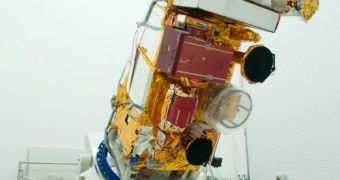According to officials managing the NASA National Polar-orbiting Operational Environmental Satellite System (NPOESS) Preparatory Project (NPP), the spacecraft has recently successfully completed all of its assessments, and is now readty to advance to the next stage.
Both the actual satellite and the five-piece scientific instrument suite underwent testing at a Ball Aerospace & Technologies Corporation production and test facility, in Boulder, Colorado.
These were the most comprehensive end-to-end compatibility tests the NPP will ever be subjected too. What they demonstrate is basically that the spacecraft is able to withstand the rigors of launch, as well as the harsh conditions in which it will operate.
The NPP Compatibility Test 4 (NCT4) laster for 4 weeks, and saw all segments of the ground system being tested thoroughly. Tested parameters also include commanding the satellite actively, and analyzing the health, safety and science data flow the spacecraft relayed.
The primary tracking antenna site for the NPP mission is located in Svalbard, Norway. The NASA Tacking and Data Relay Satellite System networks are also used to help the satellite transfer data to the ground fast and efficiently.
“The successful completion of this test has all of our NPP team members excited. It’s a major milestone that supports our readiness to launch in October,” says the NPP project integration manager, Raymond J. Pages.
The NPP is a collaborative project between NASA, the US National Oceanic and Atmospheric Administration (NOAA), the United States Air Force (USAF) and the Department of Defense (DOD).
NPP data processing centers are located at the space agency's Goddard Space Flight Center (GSFC), in Greenbelt, Maryland, as well as in Colorado, North Carolina and Nebraska. Ground system command and control components are found at the NOAA Satellite Operations Facility, in Suitland, Maryland.
“The NCT4 also served as a high-fidelity operational 'dress rehearsal' called Mission Rehearsal 3 (MR3), which simulated on-orbit operations beginning with the launch phase and continuing through instrument activation, “ a NASA press release explains.
“The successful completion of NCT4 and MR3 signifies that all mission systems are ready to proceed to launch. Additional testing will be performed during the remaining two-and-a-half months prior to launch to maintain operational and system proficiency,” the statement goes on to say.
NPP will carry five main instruments: the Visible/Infrared Imager Radiometer Suite (VIIRS), the Cross-track Infrared Sounder (CrIS), the Clouds and Earth Radiant Energy System (CERES), the Advanced Technology Microwave Sounder (ATMS) and the Ozone Mapping and Profiler Suite (OMPS).
NASA's Goddard Space Flight Center manages the NPP mission on behalf of the Earth Science Division of the Science Mission Directorate at NASA Headquarters, Washington. The JPSS program is providing the ground system for NPP. NOAA will provide operational support for the mission.

 14 DAY TRIAL //
14 DAY TRIAL //